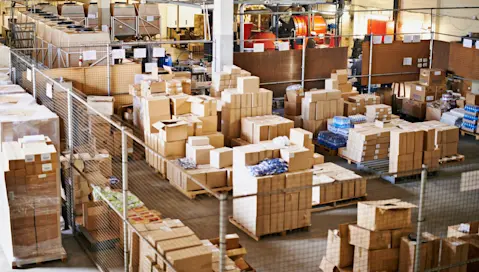Three Pillars of Sustainability for Consumer Goods Distributors
Three Pillars of Sustainability for Consumer Goods Distributors
Three Pillars of Sustainability for Consumer Goods Distributors
5 Apr 2022
Ken Weygand
The distribution industry is one of the biggest offenders when it comes to environmental issues. Logistics companies account for some 29% of greenhouse gas emissions (GHGs), while consumer packaged goods (CPG) distributors are responsible for a mind-boggling 60% of GHGs. In other words, the CPG vertical must use technologies and products that allow them to embrace sustainable business practices while still making a profit. Most of the environmental impact in the consumer sector is associated with the supply chain; however, changes throughout the company can help your business meet sustainability goals ahead of changing regulations.
According to McKinsey, consumer packaged goods companies are on the brink of unprecedented growth. With 1.8 billion people joining the consumer purchasing class by 2025, consumer spending will rise exponentially. While this is great news from a profitability perspective, the Paris Agreement of 2015 set forth strict standards for reduction of GHG emissions. The Agreement stated that CPG companies must reduce GHGs by 90% by 2050. In addition, in order to meet the current EU climate targets, CPG companies must halve greenhouse-gas emissions by 2030. Consumer goods distributors must act now—not only to meet these targets, but to stay ahead of consumer awareness of corporate responsibility.
Sustainability is a complex problem, and consumer goods distributors should consider different factors when they manage sustainability goals. The fact is though, sustainability is more than just the right thing to do—embracing sustainability is good for your bottom line. By reducing operating costs and preparing for price changes and resource shortages, sustainability strategy will give CPG companies the tools they need to lessen their environmental impact while growing their profits.
Earth Day is coming up on April 22nd, so to help you achieve simple sustainability goals, we've created this blog. In the article below, we’ll examine simple ways to drive your sustainability strategy for now—and how to maintain that strategy for the future.
Discovering Sustainable Strategy With Business Intelligence
Business Intelligence, or BI, can help you achieve sustainability objectives ahead of consumer preferences and changing regulations. How? Because it can help you minimize price changes and supply disruptions; you’ll stay ahead of your competitors; and you’ll be able to analyze and comprehend emerging risks.
Using BI can help you reduce resource use, which means when prices go up—like the astronomical landed costs distributors are facing—you can reduce costs elsewhere. You can anticipate supply chain disruptions, so you’ll be able to maintain correct supply levels and put aside resources for the future. BI can help you uncover discrepancies and problems, so you can be more proactive and quickly address them.
BI gives you the ability to assess performance through a strategic view of the operation. If you are trying to incorporate sustainable practices into every aspect of your business, using BI will unlock the data you need. BI will help you understand and then act upon the biggest environmental impacts that affect your enterprise, and then give you actionable insights with which to change them.
You can look at the balances and trade-offs and then incorporate these changes into daily operations. For example, let’s say you want to change your packaging to recycled plastics, but that packaging is more expensive. Using BI, you can add that expense into the overall cost of the product and see where you can shave costs elsewhere to absorb the rise in packaging. If you want to start building green business practices into your distribution company, using BI is a great start.
Unlock Green Practices With Supply Chain Management
The supply chain generates far greater environmental costs than in-house operations for distributors. To maintain green business practices, responsible CPG distributors must get a handle on the supply chain. Supply chain sustainability means that your company should consider the environmental impact of your product’s journey through the supply chain, from sourcing to storage, and last-mile delivery.
Nielsen reported that more than 50% of consumers would be willing to pay more for products from companies that maintain green business practices. Even if you must increase your prices to offset higher transportation costs, you can also increase your company’s reputation.
By evaluating and improving supply chain management (SCM), CPG companies can gain savings in both time and costs. Traditionally, most distributors were concerned with the speed of their deliveries; yet achieving timely deliveries need not be exclusive of responsible, green supply chain practices.
Even for small- to mid-size companies, where the price of logistics can be a make-or-break factor, small changes can lead to big payoffs. Perhaps you could try more compact packaging. This would reduce the size and number of shipments, which in turn leads to lower emissions and long-term cost savings. You can look at the impact of consolidating orders from various locations and see how that affects your profits and your environmental footprint. SCM software allows you to test various scenarios and find the one that works best at both an environmental level and a corporate one.
But you don’t have to figure this out on your own. Robust SCM software packages provide detailed analytics and pull data from across the supply chain, including your warehouse. Your business gets deeper visibility into your supply chain operations. You can find new ways to implement strategies and become more sustainable.
Reduce Your Carbon Footprint by Transforming Your Warehouse
According to a study conducted by the City University of London, warehouses account for 13% of carbon emissions in logistics. For distributors, this means that you need to find ways to make your warehouse more efficient and more sustainable. Turning off lights or automating them and setting thermostats to the correct temperatures can help manage energy use, as can adding fans to the warehouse. Painting your warehouse roof white will keep the warehouse cooler in the summer months and save you a fortune on cooling bills.
The best way to make a sustainable warehouse is to make it run more efficiently. We get it—managing a consumer goods warehouse can be labor-intensive. A good warehouse management system (WMS) makes your warehouse more efficient because it analyzes the use of floor space and helps organize inventory. This allows your team to find items quickly, as well as putting larger items where they are more easily accessed by the forklift. This reduces wasted workers hours and reduces the energy consumed by the forklift.
In addition, an advanced WMS system lets you monitor inventory levels in real time. This means you’ll always know how much stock you will need for a particular timeframe or for a special customer, and that you can provide reliable estimates on back orders. This prevents over- or understocking of items, which drastically reduces waste. Implementing a WMS helps you track every item on the warehouse floor, so you don’t have to worry about losing products or having to replace damaged items and packaging.
One of the main benefits of a WMS? It reduces or even eliminates paperwork. The system automatically generates reports, pick and pack tickets, move tickets, and packing lists—all in an electronic format. When coupled with an EDI, labels are generated correctly, which eliminates errors and guarantees compliance with your retailers. Purchase orders and returns can all be managed electronically and sent instantly—all without using any paper.
To embrace sustainability across your enterprise, you need to innovate quickly to maintain efficient operations and address changing customer needs. You must also ensure accuracy, efficiency and timeliness while eliminating excess waste and reducing energy use. You must also plan ahead, as supply chain disruptions are expected to occur well into the next year.
By allowing for improved visibility, better decision making and a better understanding of your environmental impact, digital tools like BI will play a substantial role in helping your CPG company meet and exceed changing consumer expectations and stricter international regulations. Don’t get left behind. Sustainability is about doing more with less resources, and technology can help you achieve that.
Did you know that Aptean’s Distribution ERP comes standard with WMS and SCM? We have also partnered with Microsoft Power BI to get you the best insights for your consumer goods business. Want to learn more about how these tools can transform your business? Find out how, now.
Verander uw distributieactiviteiten
Bent u klaar om uw onderneming naar een hoger niveau te tillen? Dan helpen we u graag.



